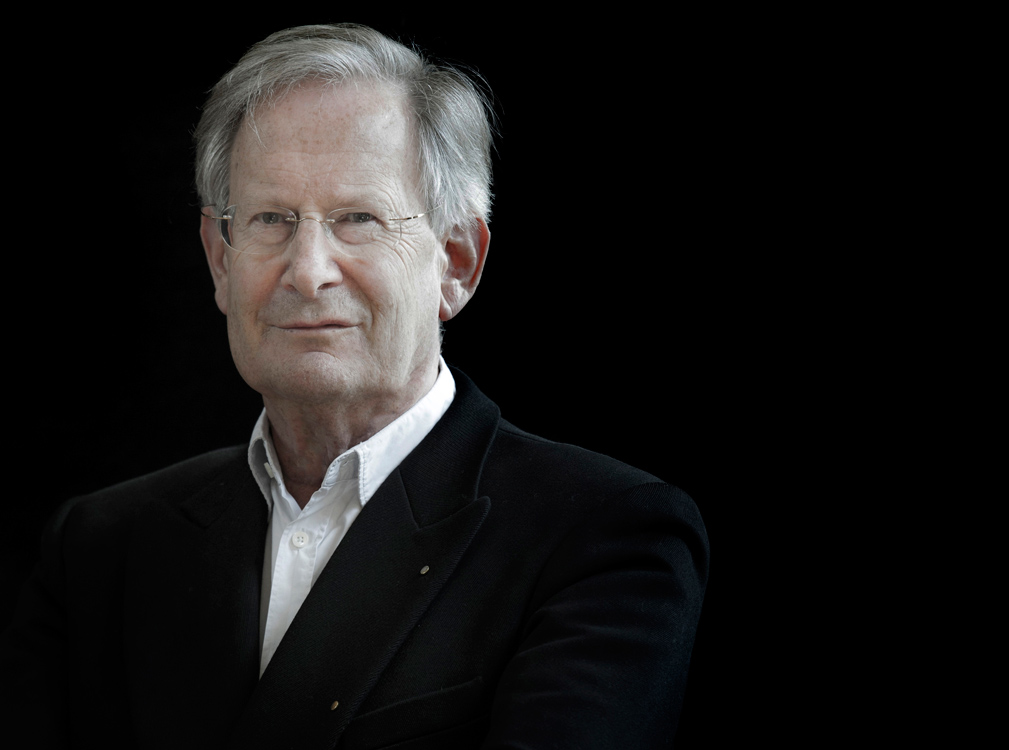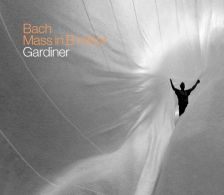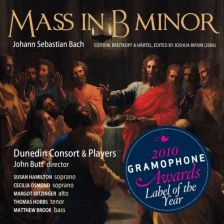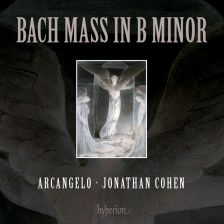Sir John Eliot Gardiner returns to Bach's B minor Mass
Lindsay Kemp
Monday, January 18, 2016
Thirty years after his first recording, Gardiner returns to this towering summit of Western music with the same forces as before. By Lindsay Kemp

‘It’s there, like Everest, isn’t it? If you’re a climber you want to climb Everest. If you’re a conductor you want to have another go at the B minor Mass.’
Sir John Eliot Gardiner has been having a busy summer, and it has taken a long time to set up this interview, but at last here we are in his south-west London home on the morning after the second of his two BBC Prom concerts (the first of Monteverdi’s Orfeo and the second of Beethoven’s Fifth and Berlioz’s Symphonie fantastique). Now, looking relaxed after a good night’s sleep and a massage, he is totally focused on the towering summit of Western music that is Bach’s B minor Mass, which he has just recorded for the second time, 30 years after the first. Not surprisingly, his answers are long, detailed and informed.
That first recording, made in 1985 in the studio for Deutsche Grammophon with his own Monteverdi Choir and English Baroque Soloists, is one that has acquired benchmark status over the years; certainly, if I am in a house where there is a recording of the Mass on the shelves, it will more often than not be Gardiner’s. It means that the new one, for his ‘own label’ SDG and made from a private concert performance at LSO St Luke’s in London earlier this year by the same forces, has some work to do to make a space for itself. ‘We didn’t get the whole picture the first time,’ explains Gardiner. ‘Not that you ever can. But now, with the experience of so many more joint outings of the work, quite apart from our far greater familiarity with Bach’s cantata output, it felt good to make a second attempt at scaling the heights. I just feel in a better place to approach it now.’
Not that he rejects the earlier recording. There are no exhortations here to put it in the bin, as I once had from Viktoria Mullova in contemplation of her first recording of Bach’s solo violin music. ‘It was when DG were giving us the opportunity to record all the big iconic Bach choral works. It was a heady time for the early music movement, so there was plenty of excitement within the group and I suppose there was inevitably a partly conscious element of positioning ourselves, making ourselves distinct from the old-fashioned, heavy-footed Lutheran tradition on the one hand, the overblown English choral society approach on the other, and at a time when the extreme minimalist slant was just coming into vogue. But, looking back on it, we were true to our values – emphasis always on textual clarity, underlying dance rhythms, the unfolding of the drama, and ensuring that the links that bind the public and private sections of the Mass are made audible. I was determined to “get it right” back then, with a very single-minded purpose to try and get everything correct as well as feeling lively. I don’t feel the same pressure recording for our own label. It’s a much more collegial process, and some of the things I was determined to do in the earlier recording I feel less strongly about now.’
Gardiner’s earlier mention of his increased familiarity with the cantatas is a reference to the major celebration of the 250th anniversary of Bach’s death that he and his musicians undertook in 2000, when they gave concert performances of all the composer’s church cantatas on or near the liturgically appropriate days at historic venues throughout Europe. (The concerts, which were recorded, form the substance of the handsomely presented complete cantata cycle on SDG.) ‘Knowing the cantatas alters your perspective of the bigger works because of the way they loom over its assembly and composition,’ he says, and certainly I can remember how, when I heard Gardiner conduct the B minor Mass at the Proms in 2004, it was obvious that his view of the work had broadened, acquired more variety, and even softened since the cantata project. ‘The large-scale works are easy to treat in isolation,’ he continues, ‘but if you can re-approach them from the aspect of Bach’s weekly output of cantatas for the church and the extraordinary achievement they represent, you can see the Passions as climaxes of the annual cantata cycles, and the Mass as a compendium of all the different styles and approaches that he took across 30 or 40 years of music-making.’
The B minor Mass, it should be remembered, is not a wholly original work but a compilation of movements adapted in the final years of Bach’s life from earlier compositions of his, mostly cantatas. The Kyrie and Gloria sections, for instance, were composed in 1733, while the Credo, Sanctus and Agnus Dei which complete the setting were added to it in the late 1740s (for reasons that are not entirely clear, but that perhaps include memorialising his own art as a church composer). Yet Gardiner clearly feels that greater understanding of the work comes not so much from comparing the music with its models, but from the wider context of Bach’s relationship with the church and his expression of it through his cantatas.
It is a subject that forms a major strand in his immensely stimulating book Music in the Castle of Heaven, written in the wake of the cantata cycle, in which he looks to these 200-or-so works, many of them still unfamiliar even to Bach lovers, for clues to the composer’s deeper personality. ‘One point I’ve changed over, both as a result of immersing myself in the cantatas so deeply and of reflecting on Bach as a composer and human being for the book, is his own tussles with belief and faith. So often the Lutherans have us believing he was a fully card-carrying Lutheran with no doubts, delivering ex cathedra statements, but I don’t think he was anything like as simple as that.’
Gardiner cites the turbulent events of the first half of Bach’s life – becoming an orphan at nine, having to find his own way as a professional musician, the deaths of his first wife and several of his children, as well as his continual struggles with authority – as formative elements in his approach to what music can express. ‘These events shake him – they would shake anybody – but it shapes him in two different ways in musical terms. First he finds a way of writing music of unbelievable consolation and comfort to people who are grieving, starting with the Actus tragicus [Cantata No 106, written in 1707 for an unidentified funeral]. It’s an absolute masterpiece, and the way he treats the ages of man and the consolation to be had suggests someone who looks to music and religion to bolster a sense of safety and worth. Then there are other moments when the less savoury aspects of some proponents of Christian belief come in for target practice: radical clergy, bigots, pharisaical people, anyone he feels is pious without backing it up with good Christian behaviour…Bach satirises like billy-o in some of the cantatas – he’s almost personal in his attacks. So I think there’s enough circumstantial evidence to suggest that his beliefs as a Christian sometimes took a wobble, and that he found a way to channel that energy of momentary disbelief into a force to encourage people in the same situation to hold faith, as well as to reassure himself and validate himself through the act of music-making.’
For Gardiner, the B minor Mass contains a glaring expression of passing doubt in the eerily hushed, chromatic transition passage that leads from the ‘Confiteor’ – significantly, one of the few newly composed sections in the piece – to the trumpet-led burst of joy that is the ‘Et exspecto resurrectionem’. ‘Why else would he write that? The beginning of that movement is so strong – “I believe in one baptism for the remission of sins” – and you think it will be stern and confident from the beginning to the end, but all of a sudden the whole edifice crumbles, it becomes murky and goes into peculiar areas away from the home key. If you look at the manuscript you can see all the difficulty Bach had finding a way out of this monumental thicket of enharmonic movement, this jungle of dissonance, but eventually he does! It’s like he’s saying, “If you have a moment of doubt, I understand, and this is what it can lead to – a terrible moment of agnosticism. But just by tipping it back into D major we’re into sunny uplands again, we’re confident again, and yes I do know there’ll be a resurrection!” Things like this make him more appealing to me as someone who’s only religious really as a result of music!’
Music in the Castle of Heaven is full of firm, personal interpretations of Bach’s church music such as these, many at a level of detail that will doubtless seem far-fetched to some people. But although Gardiner’s closeness to Bach’s music has evidently reached the point that master biographer Richard Holmes once identified as an essential process – ‘not merely a “point of view” or an “interpretation”, but a continuous living dialogue between [the biographer and his subject] as they move over the same historical ground’ – he is clear that they are still only subjective extrapolations of the text, useful as a way of appreciating and interpreting the composer’s decisions, but also a route to that elusive figure, Bach the man. ‘Someone else could come to a totally different conclusion, absolutely, but there are certain things Bach flags up by his instrumentation, by the way he sets certain texts, that suggest to me a very strong imagery. One of my favourite cantatas is No 81, Jesus schläft, was soll ich hoffen?, all about these storms on the Sea of Galilee. Jesus is asleep in the bows of the boat, and there are beleaguered Christians clinging to the mast and thinking, “Why aren’t you looking after me?” And then Jesus wakes up and says, “What’s the trouble, why are you so frantic, you of little faith?” It seems to me it’s not just a chastisement on behalf of the founder of the Christian faith, it’s actually, you know, “You’re a load of prats, I was here all the time!” It shows a certain kind of worldly wisdom and sense of fun that you don’t tend to find in the Lutheran church, or in many Lutheran interpretations of Bach’s cantatas. Bach and the church is a complex thing because Bach was really an asset to the Lutherans, but they were concerned he was stepping out of line, or perhaps the preacher had his nose out of joint because the cantata was doing a better job than his sermon was. And then as soon as he’s dead there’s a hagiolatry surrounding him, he’s regarded as the Fifth Evangelist, the saviour of Lutheranism. Both miss the point. Bach can strengthen belief, but he’s not the voice of the church. He was a deeply convinced and conscientious craftsman, but way beyond the capacity of contemporaries to understand.’
So back to the new recording of the Mass. On the face of it many things look similar to the old one, which in itself is remarkable when you consider how much has changed in the world of period performance since 1985. The forces are much the same: the Monteverdi Choir is still a mixed ensemble of 30-odd singers (including one, Nicolas Robertson, who sang in 1985), and the soloists are still mainly members of the choir. ‘I don’t believe in the B minor Madrigal,’ he says in reference to the one-to-a-part approach introduced in the 1980s by Joshua Rifkin and Andrew Parrott, and adopted by quite a few others since. ‘I don’t think there’s any evidence for it, and I don’t think there’s any great merit in doing it that way. But I am a staunch believer in having the singers emerge from the tutti and then go back, so that there’s a sense of concertino and ripieno, all honed from a general approach involving empathy and sensitivity to balance and texture within the group.’
Can Gardiner, then, reveal some of the ways his accumulated experience of the piece – and, at the age of 72, of life – has informed some of the details of his new reading? ‘Well, one thing that’s perhaps new is a sense of the fast, virtuosic trumpety movements being more distinct from one another. They don’t always need to be the same speed. I remember back in the early ’80s a distinguished English Baroque trumpeter saying to me, “John Eliot, there’s only one allegro tempo in Bach, and if you don’t follow that you’re traducing what Bach trumpets can do.” I was upset about it back then, but now I just think it’s a load of old cobblers! A movement like the ‘Et resurrexit’ is like a fast polonaise, and nothing like as fast as the ‘Cum Sancto Spiritu’ or the ‘Et exspecto’. And when you’ve got two movements in the same key that are juxtaposed, like the ‘Pleni sunt coeli’ and the ‘Osanna’, it would be very easy to make them both the same, but also a shame because the ‘Pleni sunt coeli’ is full of hemiolas and has a wonderful variable beat of dance-pulse, whereas the ‘Osanna’ is an absolutely strict one-in-a-bar pulse all the way through and has a different type of charm. You lose that if you homogenise everything.’
Indeed, relationships between movements, and concerns for the bigger picture, seem to be the main thrust of Gardiner’s rethinking of the piece. One example of this is the three movements of the Kyrie. ‘There are markings in the autograph manuscript saying “segue Christe”, “segue Kyrie”, explains Gardiner. ‘Back in 1985 I thought, “Hell, this is an injunction from Bach not to do great big rallentandos but actually to keep the flow going from one movement into the other,” so I was looking for exact proportions between ‘Kyrie I’, ‘Christe’ and ‘Kyrie II’. I feel that’s a bit of a straitjacket now. I think Bach simply meant us not to hang about, to get on with it. Those movements form a triptych, and you’ve got to feel it, but you don’t have to drive them into an artificial, rigorous continuity.’ Another example of Gardiner’s change of perspective is the widening of the canvas between the ‘Gratias’ and the ‘Dona nobis pacem’, both set to the same music. ‘The fact that the notes are the same shouldn’t blind one to the fact that the contexts are totally different,’ says Gardiner. ‘And because there are so many fewer words in the “Dona nobis”, the rhetoric and the shaping are different, and require a different Affekt.
‘Another thing that I wanted to emphasise, but didn’t do so successfully 30 years ago, was to see that there is a kind of dramatic narrative within the Mass. That may seem odd because the dramatic structure of a liturgical Mass is not similar to a Passion, but if you look at the Gloria and Credo they do have a narrative. It may be slightly disguised, and it may to some extent stop when we get into the difficult theological beliefs that you’re expected to accept like “I believe in one holy Catholic church and the remission of sins” etc, but when it’s dealing with the life of Christ it has a narrative that you find in the cycles of cantatas as well. The first half of the liturgical year, from Advent to Trinity, is all about the life of Christ up to the Ascension, and that, in microcosm, is what you find in the Credo of the Mass. Bach, not being an opera composer but intensely dramatic, brings out that narrative thread. I find it very compelling, so yes, I suppose it’s much more in evidence in the performance now.’
Gardiner could probably talk for hours about Bach and the B minor Mass, just as when you read his book you suspect he could have produced twice as many pages as he actually settled on. Do his gathered observations run through his head when he conducts? ‘No, I’m just aware of how unbelievably perfect the music is, and how our job here, in this moment on earth, is to do justice in any way possible we can to Bach’s vision. If you can get anywhere close to fulfilling what seem like his ideals through the way he’s notated his music, you’re on the right track. I feel inspired by Bach, and if that means one has religious feelings as a result of the extraordinarily spirituality of his music, all well and good, but to me it’s not a means to an end, it’s an end in itself. The end is the ineffable beauty of this music.’
Recommended recordings: Bach's B minor Mass

Hannah Morrison sop Esther Brazil mez Meg Bragle, Kate Symonds-Joy contrs Peter Davoren, Nick Pritchard tens Alex Ashworth, David Shipley basses Monteverdi Choir; English Baroque Soloists / Sir John Eliot Gardiner
(Soli Deo Gloria)
‘Gardiner’s admiration for this work is palpable in every bar...In the grip of its conceits and its virtuoso executancy, captured in the strikingly immediate recorded sound of LSO St Luke’s, this High Mass joins a distinguished discography at high table...’ Read the review

Susan Hamilton, Cecilia Osmond sops Margot Oitzinger alt Thomas Hobbs ten Matthew Brook bass Dunedin Consort and Players / John Butt
(Linn)
‘Although an excellent one-voice-per-part version is nothing new, Butt’s insightful direction and scholarship, integrated with the Dunedin’s extremely accomplished instrumental playing and consort singing, amount to an enthralling and revelatory collective interpretation of the Mass in B minor...’ Read the review

Lydia Teuscher, Ida Falk Winland sops Tim Mead counterten Samuel Boden ten Neal Davies bass Arcangelo / Jonathan Cohen
(Hyperion)
‘This is a performance where character and rich dimension emerge from within a patient and naturally projected vision of Bach’s most celebrated compendium. The work infrequently speaks with such gracefulness, freedom or conviction...’ Read the review
Explore Bach's life and music...
Top 10 Bach recordings
Here are 10 works by Bach that are essential listening; and once bitten the Bach Bug will take you on a journey of almost limitless reward... Read more
Is Bach Best?
Was Bach a genius? Or simply a superb technical craftsman? Simon Heighes tries to pin down Bach's genius with a little help from some friends... Read more
This article originally appeared in the November 2015 issue of Gramophone.











